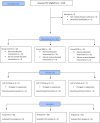Effects of anterior quadratus lumborum block versus erector spinae plane block on postoperative acute pain in percutaneous nephrolithotomy: a prospective, observational study
- PMID: 39256675
- PMCID: PMC11386376
- DOI: 10.1186/s12871-024-02691-7
Effects of anterior quadratus lumborum block versus erector spinae plane block on postoperative acute pain in percutaneous nephrolithotomy: a prospective, observational study
Abstract
Background: The study aimed to compare the pain-relieving effectiveness of anterior quadratus lumborum block (QLB3) and erector spinae plane block (ESPB), both of which have been documented to provide relief during abdominal surgery.
Methods: This prospective observational study, conducted between February and July 2023, included 96 patients who had undergone percutaneous nephrolithotomy (PCNL). Patients were divided into three groups: QLB3, ESPB, and control (no block) and received the corresponding nerve block in the preanesthetic room for regional block. Cumulative morphine consumption during the initial 24 h after PCNL, numerical rating scale resting/movement scores, intraoperative remifentanil usage, rescue analgesic requirements, time when the first analgesic was requested, and postoperative nausea and vomiting scores were documented and compared between the groups.
Results: Total median morphine consumption in the first 24 h postoperatively was similar in the QLB3 and ESPB groups but higher in the control group (QLB3, 7 mg [(Q1-Q3) 7-8.5]; ESPB, 8 mg [6.5-9]; control, 12.5 [10-17]; P < 0.001). Similarly, median intraoperative remifentanil consumption did not differ between the block groups but was higher in the control group (QLB3, 1082 µg [IQR 805.5-1292.7]; ESPB, 1278 µg [940.2-1297.5]; control, 1561 µg [1315-2068]; P < 0.001). The number of patients receiving rescue analgesic medication was similar in the block groups but higher in the control group (QLB3, n = 9 [30%]; ESPB, n = 14 [46.7%]; control, n = 21 [70%]; P = 0.008).
Conclusions: QLB3 and ESPB were adequate and comparable in providing postoperative analgesia as part of multimodal analgesia after PCNL.
Trial registration: The study was registered on ClinicalTrials.gov (Identifier: NCT05822492).
Keywords: Acute postoperative pain; Erector Spinae plane block; Nerve block; Percutaneous nephrolithotomy; Quadratus lumborum block; Ultrasonography.
© 2024. The Author(s).
Conflict of interest statement
The authors declare no competing interests.
None.
Figures



References
Publication types
MeSH terms
Substances
Associated data
Grants and funding
LinkOut - more resources
Full Text Sources
Medical

